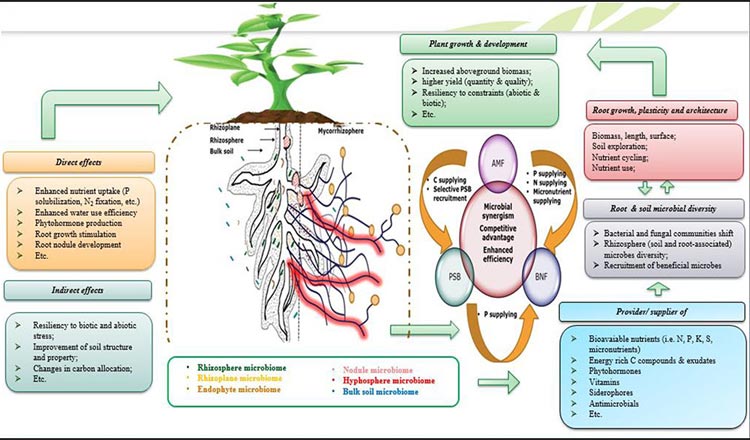Vermicoat®
Section 1:
What is a Vermicoat®?
A Vermicoat® is the Biological Priming of seed with living Microbes placed inside the endosperm, as well as the placement of a thin coating of earthworm organic humus material and microbes unto the outside seed surface; in order to enhance plant growth with Plant Growth Promoting Rhizobacteria and Free-living Nitrogen Fixing Microbes.
Earthworm gut microbes in and on the seed restore soil biological diversity and improve the plant’s root health, nutritional reach and raises yield.
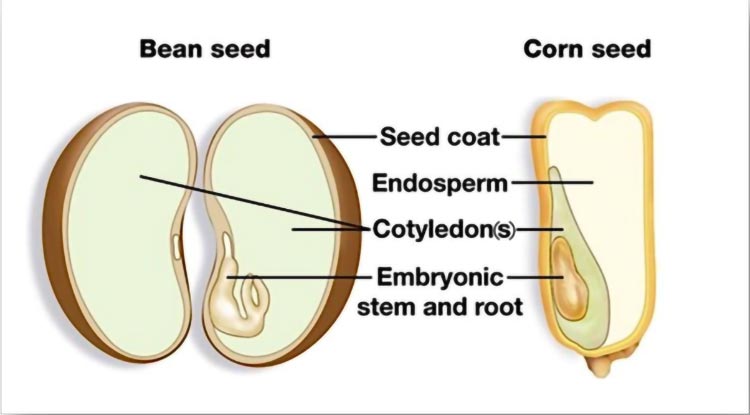
Placing Living Microbes inside a Seed is called Biological Priming, or Bio-prime® in short.
Placing a Soil Earthworm coat on the outside surface of a seed is called Vermicoating, or Vermicoat® in short, and it is an extension of Bio-priming to magnify the yield gain.
The Vermicoat® Process happens in two phases:
Phase 1:
Seed is first Biologically Primed by a hydrating it in a limited amount of water mixed with Bio-Prime® Earthworm Soil Microbes, Plant Growth Promoting Bacteria and Plant Growth Promoting Fungi. The dry seed suck up the moisture and Bio-Prime® living microbes and the process of germination begins, but it is not completed. There is a separate website www.bioprime.co.za explaining Biological Priming in greater detail.
Phase 2:
Once seed has been Biologically primed with living microbes and some moisture inside the endosperm, the process of priming is magnified by coating the outer seed surface with in-soil earthworm microbes, earthworm humus, organic growth stimulants and biological boosters called bio-stimulants.
A Vermicoat ® is a magnified form of Bio-priming of seed; and is regenerative agriculture in action, restoring soil bio-diversity by means of expanding the diversity of soil microbes (bacteria and fungi) for maximum soil nutrient use functionality and greatest yield gains.
Bio-Prime® is what you need to place living soil microbes inside the endosperm.
Vermicoat® is the same inside the seed, but with an additional expanded outer coating as well- what you need to additionally place living soil microbes and organic nutrients as a coating on the outside of the seed surface, over and above the internal endosperm Microbes. It magnifies the biological boost during the germination process, and result in a much larger root system, much quicker, resulting in bigger yields from higher nutrient uptake eeificency.
Typically, bio-priming Canola, Soybean or Maize seed adds up to 500 kg of yield per ha per year on average, while Vermicoat® adds another up to 500 kg of yield per ha, for a potential combined 1 ton yield gain. Where does the extra yield come from? It comes from a higher microbial population which is more diverse, and which is able to make existing nutrientsin the soil more plant available.
Why are Bio-Prime® and Vermicoat® needed inside and outside seeds?
- Long term use of herbicides such as Round-up/Glyphosate/2-4D, Triazine etc has serious negative health effects for soil microbial diversity lowering yield potential of commercial crops such as Canola and Soybean (https://www.frontiersin.org/articles/10.3389/fenvs.2021.763917/full ).
- Long term use of chemical fertilizers negatively affects the microbial diversity of agricultural soils also lowering yield potential. If you Google the name of the herbicide you use active ingredient, and its effect on soil microbial diversity and soil function, you will only get bad news results in terms of soil health. You will see that your soil loses certain types of microbes that are critical to the optimal health of your soil and thus limit yields. With long term commercial herbicide use soil microbial diversity is lost.
- Example: Canola and Soybean both have 4–6-ton ha year genetic yield potential, but average harvests are in the 2.5-ton ha year range. The reason for this is due to the loss of microbial diversity in the soils due to herbicides and chemical fertilizer which hampers the microbial root feeding networks of plants, impairs nutrient use efficiency and restrict yields. https://foodprint.org/issues/how-industrial-agriculture-affects-our-soil/
- A Vermicoat® on commercial seed simulates a visit to the seed by numerous classes of earthworms with all the benefits and soil diversity health restoration that entails, typically adding 500 kg to 1000 kg of additional Canola,Maize and Soybean yield per hectare per year due to better function root microbial networks.
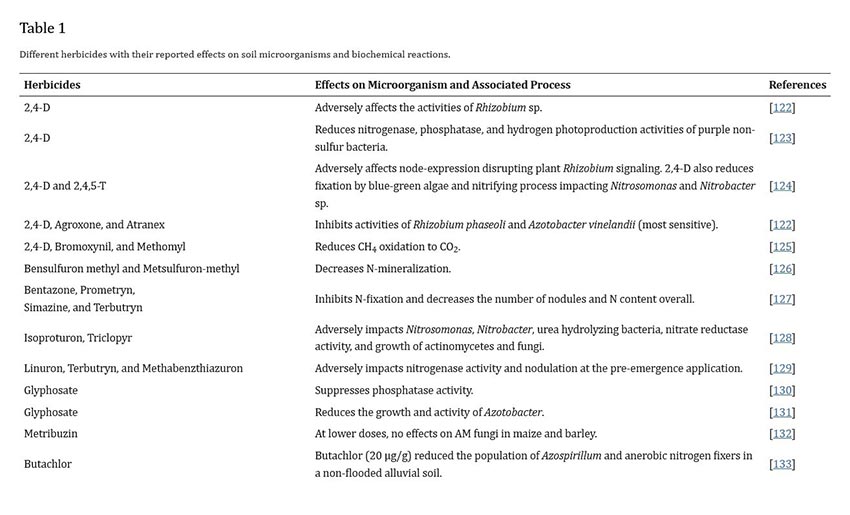
Kindly see https://www.ncbi.nlm.nih.gov/pmc/articles/PMC8910389/ for more information on the full list of herbicides and their negative effectson soil microbial diversity. The result of this is that with fewer soil microbial diversity, nutrient uptake efficiency is lowered.
Nutrient Use Efficiency in modern Agriculture
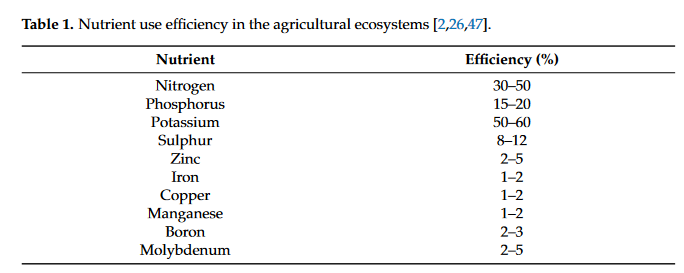
Do you even know what the modern agricultural nutrient uptake efficiency is? Bio-prime® and Vermicoat® improves this drastically by increasing the microbial diversity (bacteria and fungi) and numbers of Soil Microbeson each seed, which are able to make more nutrients more plant available. It is a shift towards nutrient mining, and using existing nutrients what you already have in your soil, instead of adding yet more chemical fertilizer with ultra-low nutrient use efficiency.
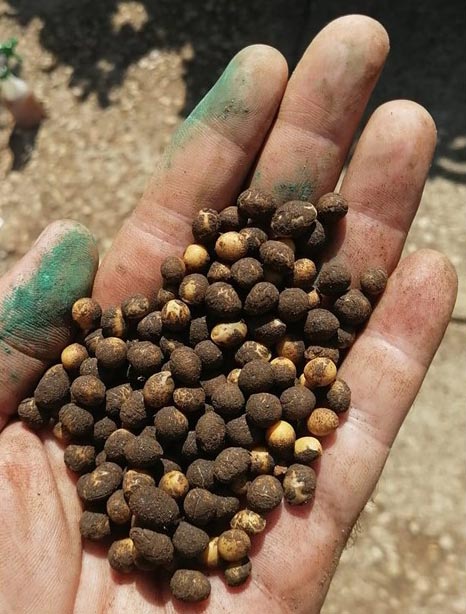
Simplified illustration of the microbial consortia concept highlighting beneficial rhizosphere PGPM and their direct (i.e., nutrients uptake via fixing N2, solubilizing P, producing plant growth promoting (PGP) substances like indole acetic acid, gibberellin, and cytokinin, etc.) and indirect effects (i.e., alleviation and/or protection against biotic and abiotic constraints) on root growth, symbiotic (rhizobial and mycorrhizal, etc.) and aboveground (plant growth, productivity, etc.) plant performance. Heterogeneity of the rhizosphere and root beneficial microbiome influences root growth and plasticity of root architecture that lead to effective exploration of soil and thus efficient nutrient uptake with positive consequences on growth and yield of the plant host. This all leads to higher nutrient uptake efficiency. For more info kindly see https://www.frontiersin.org/journals/microbiology/articles/10.3389/fmicb.2018.01606/full
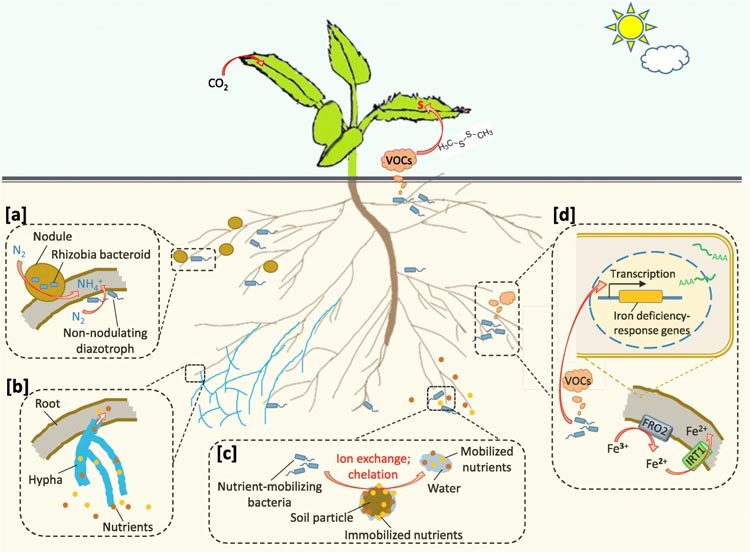
What is the purpose of this Vermicoat® Website:
This website overviews the logic chain and use of Vermicoat® for any type of seed, specifically Canola, Soybean, fine seed and (round seed) Maize production and explains on farm Do-It-yourself Vermicoat® application -in order that you get better nutrient uptake in your soil from a wider diversity of Soil Microbes for better yield.
If you want to get 1 ton per ha year additional yields, do your homework and master this improved nutrient uptake value and logic chain.
To study Bio-prime® of Seeds in detail kindly see our sister website www.bioprime.co.za to better understand where half of the yield gain comes from in Phase One; and see how to Do It Yourself. Once you have mastered Bio-priming conceptually you can further study this www.vermicoat.com website for Phase 2 and proceed to order the material.
How can a Bio-prime® and Vermicoat® be used?
- You can order the “Do It Yourself”-Bio-prime® and Vermicoat® material by courier and biologically prime and coat your seed yourself. It is easy to do and pretty like adding Rhizobium unto legume seed, with step-by-step instructions and premix liquid and coating material. No special skills required. This is ideal if you want to hydrate the seed with microbes, coat it and test on a few seed bags of 20-25 kg each. You order it and get it delivered by courier overnight, prime andcoat it by hand and once you see that it works from the yield gain, you can take it further with your next harvest
- For large commercial farmers planting a huge number of tons of seed we can send out mobile seed coating machines and help you coat the seed in your shed on your farm – for instance 180 tons of soybean seed for 1000 ha. You order it months in advance and pay a 50% deposit on order, and the seed is coated in the 30 days before the rain starts on your farm using custom mobile coating machines.
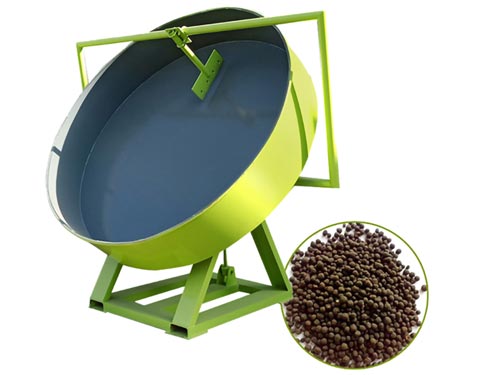
What are the technical advantages of using a Vermicoat® on Seed?
- Canola, Soybean, and any fine seed can be planted 1-2cm deeper than normal and will still emerge due to the additional nutrients and microbes on the seed surface boosting growth. There is a lot more moisture and nutrients 3-4cm deep in the soil profile, instead of in the top 1-2 cm of the soil that dries out easily. With a Vermicoat®, seed is planted in the wet soil at 4 cm and seedlings can survive much longer between rainfall events, lowering climatic risk.
- A Vermicoat® is a solution against erratic rainfall, heatwaves and La Nina climatic extremes making conventional planting in the top 2 cm of the dry soil risky-if you do not have regular rainfall plant population densities drop quickly and losses mount.
- A Vermicoat® plant will grow a larger root system and the soil biology in and on the seed will immediately integrate the plant into a common microbial market; trading nutrients over the entire field for plant sugars and carbon- leading to faster root and plant growth. Instead of roots having a 15-30 cm reach they can now have 3-10 meters wide reach.
- The earthworm gut microbes on the seed will increase the biological size and reach of the plant root system by up to 700% accessing nutrients far from the physical plant roots and bringing those nutrients to the plant by means of microbial action-both bacterial as well as fungal.
- 20-60% higher yield is possible due to earthworm Plant Growth Promoting Rhizobacteria stimulating plant growth as per https://www.nature.com/articles/srep06365
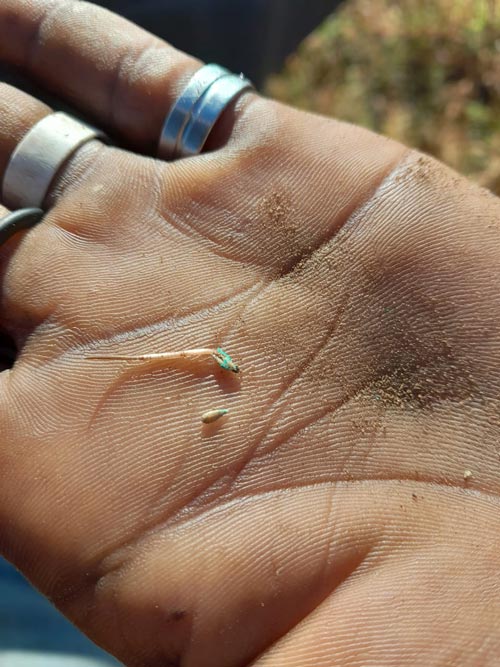
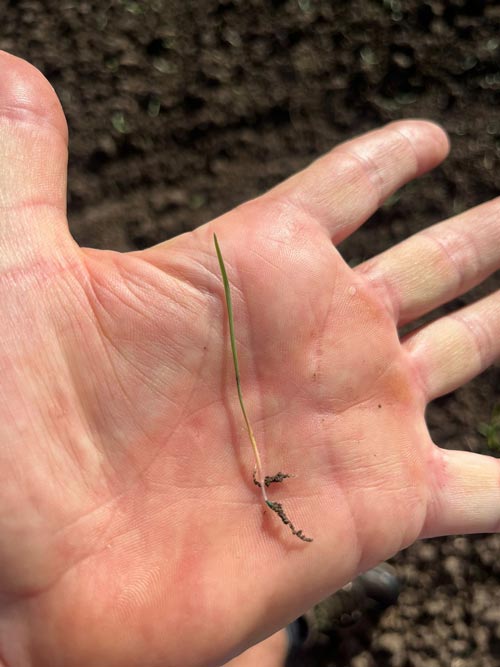
What does Vermicoat® earthworm gut microbes do to Plant Growth?
I. 20-40% higher yields. (Canola and Soybean yields are typically increased by 500 kg to 1 ton ha year when planted with a Vermicoat®)
II. 20-40% increased plant hardiness against water stress, heat stress and disease challenge.
III. 20-40% increased grain quality.
IV. Nitrogen fertilizer use can be cut by up to 100% in the case of Canola and Soybean when earthworm gut microbes are combined with free living biological nitrogen fixing bacteria producing 80 N ha (250 kg Urea/KAN equivalent) in addition to Rhizobium. The following photos are from Vermicoat® Soybean with zero Nitrogen or Phosphate fertilizer added (in-furrow micro elements from Kelp at planting and normal Rhizobium inoculation).
V. Example of upside potential-what you save on Nitrogen fertilizer per ha pays for the Vermicoat® soil biology: R1000 per ha cost, additional 0.5 to1 ton of Canola or Soybean yield = R8500per ha extra. Every R1 turns into R4 to R8.50.
.
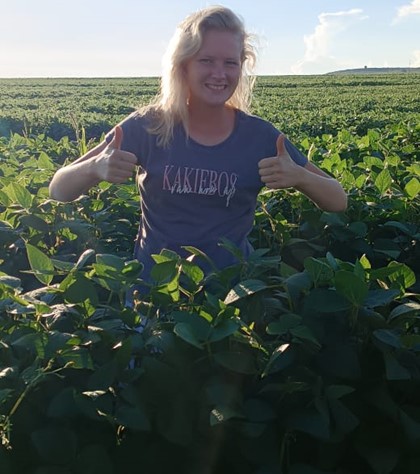
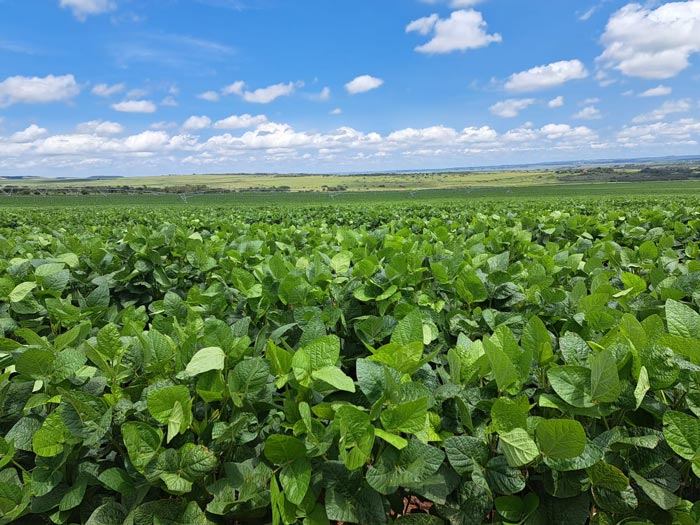
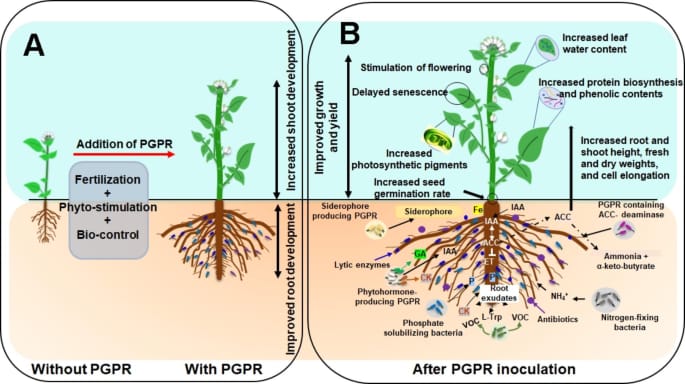
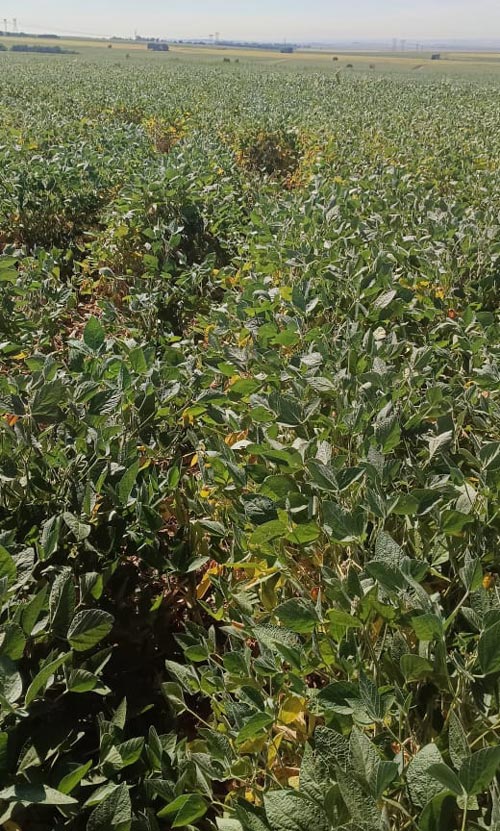

New Season Seed Germination trials in an Earthworm Soil Bath
- Note how the seed respond to the Earthworm Plant Growth Promoting Rhizobacteria in the bath.
- We cannot plant your commercial Canola and Soybean seed in the bath due to a lack of space, but we can extract the soil biology from the earthworm gut and place it on every seed you wish to plant and get the same effect.
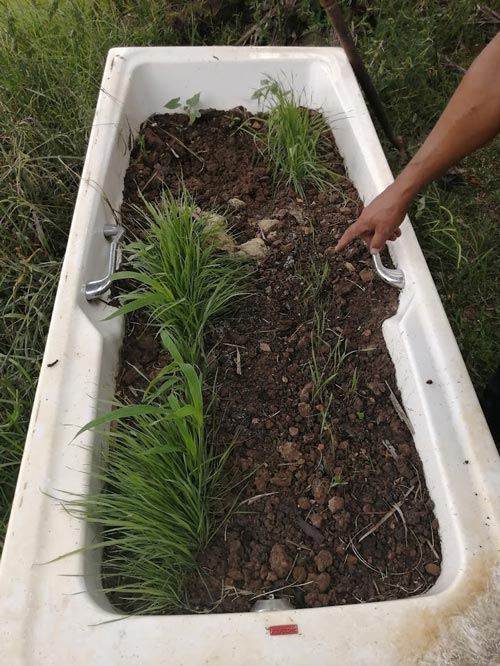
Which type of soils benefit most from a Bio-Prime® Vermicoat® on the Seed?
- Any soil with a heavy herbicide application history which negatively affects soil biology, and in which chemical residues builds up in the soil over time.
- Any soil with a long history of heavy chemical fertilizer use, especially ammonium sulphate and nitrate-which tend to deplete soil humus and microbiology with long term NPK use and which alter the soil biology, leading to a loss of microbial diversity, especially in the beneficial fungi.
- Tilled and ploughed soil where soil structure, soil organic matter and soil biology is not ideal.
- In such soils the Bio-Prime® Vermicoat® microbes bring back the microbial diversity, restoring root trade network capabilities, and are thus able to mine many historic leached nutrients that are normally not plant available in the full soil profile. The microbes also break down and neutralise herbicide residues; and allow humus formation with high soil microbial activity and fast crop residue decomposition.
- The second season of Vermicoat ® typically yield very good to better results, as the legacy microbes on the roots in the first year remain after the harvest and can transport mined nutrients and water to the new young plants in year 2 creating an even bigger trading network down to deeper depth quicker, than in year 1.
Summary of Bio-Prime® Vermicoat® Cost Breakdown of R1000 per ha:
- Bio-Prime® cost R500, and contains in-soil earthworm gut liquid (not vermiwash from Red Wrigglers) which can be mixed with up to 40 Liters of water and a 1kg microbial inoculant that is mixed with water and sucked into the seed endosperm.
- Vermicoat® cost R500 per ha for the -In Soil Earthworm Powder Coatings x 2 and Microbial spray x 1. It includes:
- The free-living Nitrogen Microbes applied to the seed of 80 N ha equal to 250 kg of Urea/KAN x 1. (Remember that 100 kg of KAN is only 28 N).
- The Vermicoat® combined cost benefit analysis is basically R1000- for an additional 500kg to 1000 kg of yield per ha in normal commercial farming soils in an average year. If Canola or Soybean is R8500 per ton, a 500 kg yield increase is worth R4250 and a 1-ton worth R8500 ton (Example price).
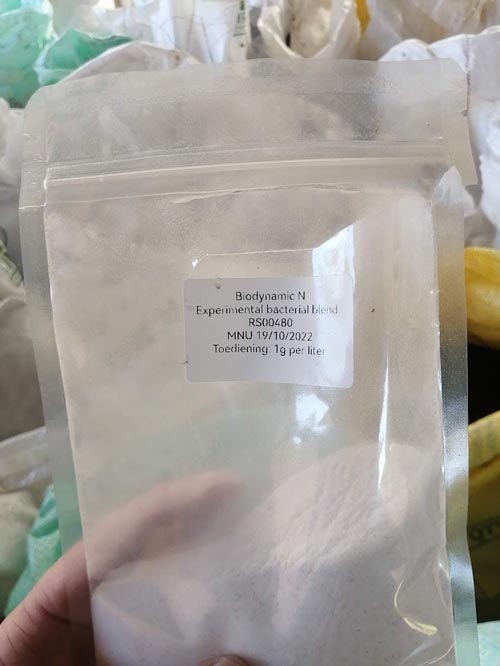
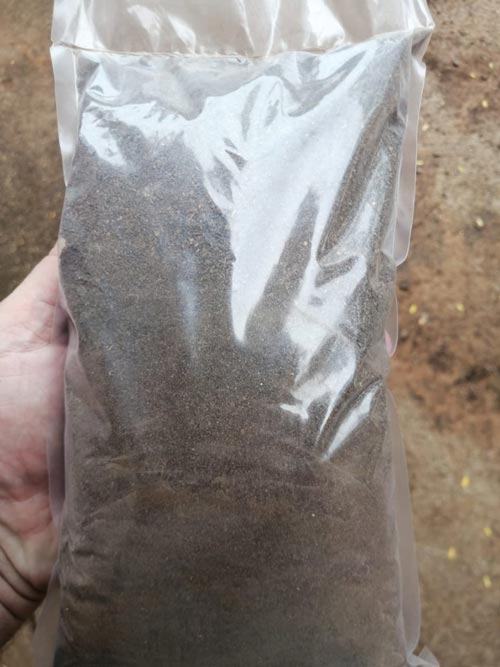
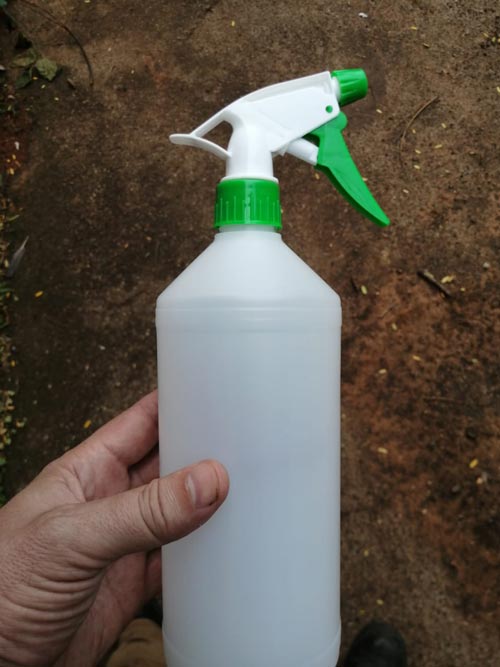
How does one Bio-Prime® and Vermicoat® your seed yourself?
I.Order the Bio-prime® Vermicoat® materials online from us and get it at your closest Postnet or Pep.
II. The material is marked 1 to 5 and you apply it in sequence from 1 to 5. You get full instructions and support, for example:
III.
- Step One:Nitrogen powder is mixed into the specified amount of water together with Bio-Prime® liquid and gently mixed.
- Step Two: Some moist Earthworm inoculation powder is also mixed into the water.
Step Three: The specified amount of moisture mix is carefully applied to the seed during mixing, and the dry seed is allowed to suck up most of the biologically activated moisture.
Step Four. Once the seed has suck up most of the moisture during mixing, the dry bag of earthworm powder and then the dry bag of red binder material is added gently mixing it in. It will add a thin film coating layer on the surface of the seed called a Vermicoat® and will set after a few minutes of mixing.
Step Five: The binder is added to the seed coating making it loose and friable so that it will flow easily through the planter. As it dries you can make sure no pebbles form by breaking up any pebbles between your hands.
Step Six: The seed is put in a bag and dried out in the shade in a cool breeze before planting.
IV. Each seed type has a specific recipe depending on the volume per ha and it gets a custom mix and specified amount of moisture. Check in with us. Fine seed is typically by hand while large volume soybean seed or round seed is mixed by machine -from cement mixers to custom machinery.
V. The general principle is to wet all the seed with a specified amount of moisture not allowing full germination, and then to dry it out using the bone-dry earthworm powders and dry binder to keep it in a biologically primed status.
VI. Once planted when the Vermicoat® seed gets rain- it will germinate as if in the earthworm soil bath, and immediately activate microbial feeder networks stimulating plant growth as per the pictures.

Example of DIY Bio-Prime® Vermicoat® for Canola 20 kg bag:
Canola Vermicoat® package per 20 kg seed bag for 8 ha @R8000:
- 1 x 1 kg moist earthworm powder.
- 1 x 1 kg dry earthworm powder.
- 1 x 1 kg dry red binder powder.
- 8 x 100-gram package of Nitrogen fixing microbes,
- 1 Liter of Earthworm gut liquid in a spray bottle to also use during Bio-Prime® process.
- Total weight about 5 kg. Cost to deliver R100 Postnet or PEP.
- Enough material for 8 ha worth of Canola seed in either a light film coating or heavier encrusted coating depending on what the planter can handle without clogging.
This website will further explain the Vermicoat® Ecotechnology, with the fundamental concepts and the definitions overviewed in the following short video:
Why do my plants always struggle and not give their genetic yield potential of 3-4 tons ha? Fungi & bacteria are missing!
Video of 4.8 ton to 5-ton Soybean Harvesting after a Free-living Biological
Nitrogen microbe trial on the seed:
